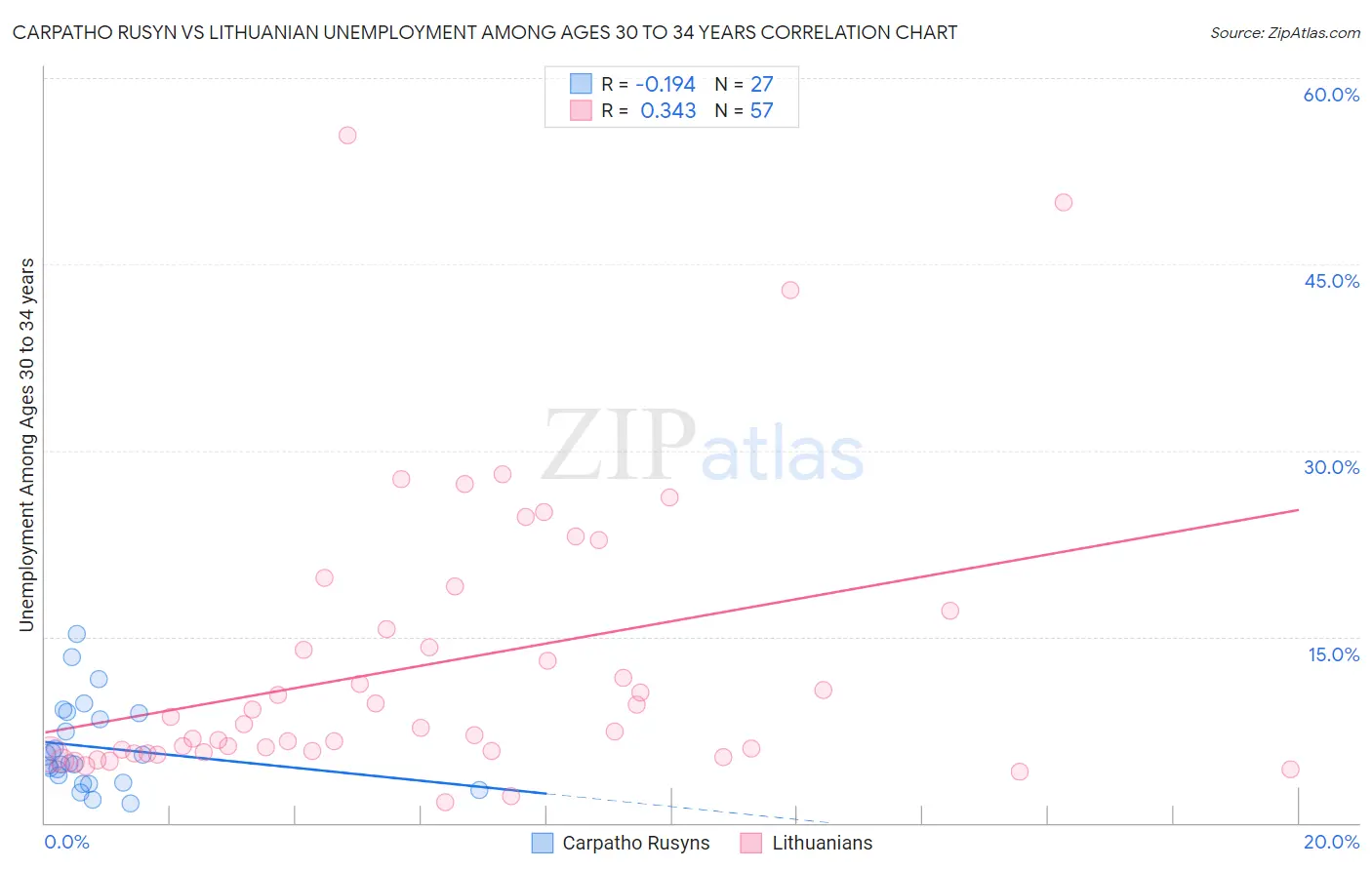Carpatho Rusyn vs Lithuanian Unemployment Among Ages 30 to 34 years
COMPARE
Carpatho Rusyn
Lithuanian
Unemployment Among Ages 30 to 34 years
Unemployment Among Ages 30 to 34 years Comparison
Carpatho Rusyns
Lithuanians
5.3%
UNEMPLOYMENT AMONG AGES 30 TO 34 YEARS
77.3/ 100
METRIC RATING
132nd/ 347
METRIC RANK
5.4%
UNEMPLOYMENT AMONG AGES 30 TO 34 YEARS
72.4/ 100
METRIC RATING
139th/ 347
METRIC RANK
Carpatho Rusyn vs Lithuanian Unemployment Among Ages 30 to 34 years Correlation Chart
The statistical analysis conducted on geographies consisting of 57,625,902 people shows a poor negative correlation between the proportion of Carpatho Rusyns and unemployment rate among population between the ages 30 and 34 in the United States with a correlation coefficient (R) of -0.194 and weighted average of 5.3%. Similarly, the statistical analysis conducted on geographies consisting of 389,471,500 people shows a mild positive correlation between the proportion of Lithuanians and unemployment rate among population between the ages 30 and 34 in the United States with a correlation coefficient (R) of 0.343 and weighted average of 5.4%, a difference of 0.46%.

Unemployment Among Ages 30 to 34 years Correlation Summary
| Measurement | Carpatho Rusyn | Lithuanian |
| Minimum | 1.6% | 1.7% |
| Maximum | 15.2% | 55.4% |
| Range | 13.6% | 53.7% |
| Mean | 6.1% | 12.7% |
| Median | 4.8% | 7.7% |
| Interquartile 25% (IQ1) | 3.2% | 5.7% |
| Interquartile 75% (IQ3) | 8.8% | 16.3% |
| Interquartile Range (IQR) | 5.6% | 10.7% |
| Standard Deviation (Sample) | 3.5% | 11.4% |
| Standard Deviation (Population) | 3.4% | 11.3% |
Demographics Similar to Carpatho Rusyns and Lithuanians by Unemployment Among Ages 30 to 34 years
In terms of unemployment among ages 30 to 34 years, the demographic groups most similar to Carpatho Rusyns are Immigrants from Northern Europe (5.3%, a difference of 0.0%), Immigrants from Eastern Europe (5.3%, a difference of 0.010%), German (5.3%, a difference of 0.050%), Bangladeshi (5.3%, a difference of 0.070%), and Polish (5.3%, a difference of 0.15%). Similarly, the demographic groups most similar to Lithuanians are Immigrants from North America (5.4%, a difference of 0.020%), Immigrants from Europe (5.4%, a difference of 0.030%), Immigrants from Greece (5.4%, a difference of 0.030%), Serbian (5.4%, a difference of 0.050%), and Russian (5.4%, a difference of 0.11%).
| Demographics | Rating | Rank | Unemployment Among Ages 30 to 34 years |
| Greeks | 80.4 /100 | #125 | Excellent 5.3% |
| Immigrants | Sri Lanka | 80.2 /100 | #126 | Excellent 5.3% |
| Taiwanese | 79.4 /100 | #127 | Good 5.3% |
| Immigrants | Uruguay | 79.3 /100 | #128 | Good 5.3% |
| Poles | 78.8 /100 | #129 | Good 5.3% |
| Germans | 77.8 /100 | #130 | Good 5.3% |
| Immigrants | Eastern Europe | 77.4 /100 | #131 | Good 5.3% |
| Carpatho Rusyns | 77.3 /100 | #132 | Good 5.3% |
| Immigrants | Northern Europe | 77.3 /100 | #133 | Good 5.3% |
| Bangladeshis | 76.6 /100 | #134 | Good 5.3% |
| Palestinians | 75.1 /100 | #135 | Good 5.4% |
| Pakistanis | 74.6 /100 | #136 | Good 5.4% |
| Immigrants | Canada | 74.6 /100 | #137 | Good 5.4% |
| Serbians | 72.9 /100 | #138 | Good 5.4% |
| Lithuanians | 72.4 /100 | #139 | Good 5.4% |
| Immigrants | North America | 72.2 /100 | #140 | Good 5.4% |
| Immigrants | Europe | 72.1 /100 | #141 | Good 5.4% |
| Immigrants | Greece | 72.0 /100 | #142 | Good 5.4% |
| Russians | 71.1 /100 | #143 | Good 5.4% |
| Immigrants | Russia | 71.0 /100 | #144 | Good 5.4% |
| Syrians | 70.3 /100 | #145 | Good 5.4% |